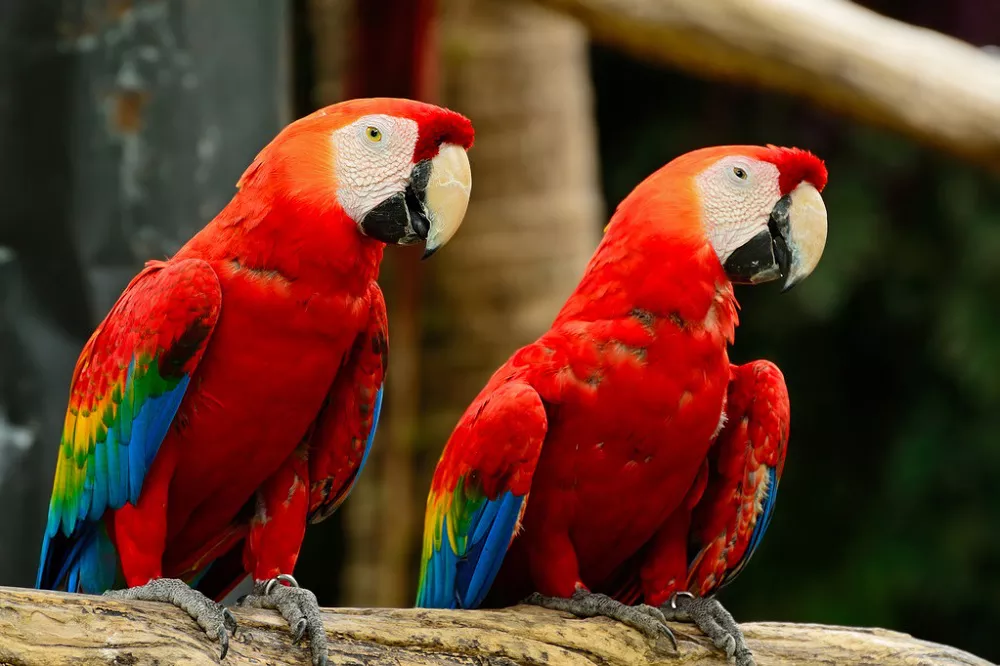The Scarlet Macaw (Ara macao) is a stunning and majestic bird that inhabits the rainforests of Central and South America. This bird has evolved several adaptations that have enabled it to thrive in its natural habitat, which is characterized by a diverse array of plant and animal life, a high level of rainfall, and a humid climate. These adaptations can be broadly categorized into four main areas: diet, physical characteristics, social behavior, and response to human activity.
Diet:
Scarlet Macaws are primarily frugivorous, meaning that they feed mainly on fruits, nuts, and seeds. This diet is well-suited to their environment, as the rainforest provides a plentiful supply of these food sources. The birds have strong beaks that allow them to crack open hard nuts and seeds, and their long, flexible tongues can reach deep into fruits like papaya and mango to extract the pulp.
In addition to their diet, Scarlet Macaws have a unique digestive system that enables them to consume certain fruits that are toxic to other animals. This is due to the presence of bacteria in their gut that breaks down harmful chemicals, allowing the birds to extract the nutritional content of the fruit while avoiding its toxic effects.
Physical Characteristics:
Scarlet Macaws have several physical adaptations that enable them to survive in their rainforest habitat. One of the most noticeable is their bright, colorful plumage, which serves several functions. The bright colors help the birds to attract mates, as well as to identify members of their own species. Additionally, the colors may serve as a form of communication, signaling aggression or territoriality to other birds.
The birds’ wings are also well-adapted to their environment. They have long, pointed wings that enable them to fly swiftly and gracefully through the dense forest canopy, where they search for food and mates. Their wings are also powerful, allowing them to fly long distances in search of food and to evade predators.
Social Behavior:
Scarlet Macaws are highly social birds that form tight-knit flocks with other macaws. This behavior is important for several reasons. First, it helps the birds to find food and to avoid predators. By foraging in a group, the birds can share information about the location of food sources and the presence of predators. Second, the social bonds that form within a flock may help to increase the birds’ chances of successfully reproducing. Birds that are part of a large, stable flock may be more likely to find suitable mates and to successfully raise their offspring.
Response to Human Activity:
Scarlet Macaws have also adapted to the presence of humans in their environment. While human activity has had a negative impact on many species of birds, some Scarlet Macaws have learned to live alongside humans in urban and agricultural areas. These birds have adapted to human structures like telephone poles and buildings as potential nesting sites, and have learned to scavenge for food in areas like fruit orchards and corn fields.
Nesting and Breeding Strategies:
Scarlet macaws exhibit unique nesting and breeding behaviors that contribute to their successful adaptation in the rainforest. These parrots prefer to nest in tree cavities, which provide protection from predators and the elements. They often select large, mature trees with hollow trunks or branches, or they excavate their nesting cavities in dead or decaying trees. Such nesting strategies ensure that their vulnerable young are sheltered and hidden, reducing the risk of predation.
In conclusion, the Scarlet Macaw is a fascinating bird that has evolved several adaptations that enable it to survive and thrive in the rainforest environment. Its diet, physical characteristics, social behavior, and response to human activity are all important factors that have contributed to its success in this challenging habitat. As we continue to study these birds, we can learn more about their adaptations and the ways in which we can protect them and their habitat for future generations.
Related topics:


 Facebook
Facebook  Instagram
Instagram  Youtube
Youtube 